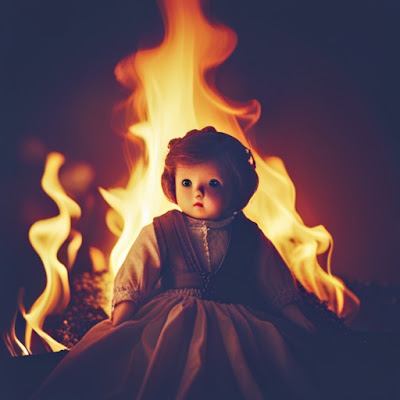The distant light which Eustacia had cursorily observed in leaving the house came, as she had divined, from the cottage window of Susan Nunsuch. What Eustacia did not divine was the occupation of the woman within at that moment. Susan’s sight of her passing figure earlier in the evening, not five minutes after the sick boy’s exclamation, “Mother, I do feel so bad!” persuaded the matron that an evil influence was certainly exercised by Eustacia’s propinquity.
On this account Susan did not go to bed as soon as the evening’s work was over, as she would have done at ordinary times. To counteract the malign spell which she imagined poor Eustacia to be working, the boy’s mother busied herself with a ghastly invention of superstition, calculated to bring powerlessness, atrophy, and annihilation on any human being against whom it was directed. It was a practice well known on Egdon at that date, and one that is not quite extinct at the present day.
She passed with her candle into an inner room, where, among other utensils, were two large brown pans, containing together perhaps a hundredweight of liquid honey, the produce of the bees during the foregoing summer. On a shelf over the pans was a smooth and solid yellow mass of a hemispherical form, consisting of beeswax from the same take of honey. Susan took down the lump, and cutting off several thin slices, heaped them in an iron ladle, with which she returned to the living-room, and placed the vessel in the hot ashes of the fireplace. As soon as the wax had softened to the plasticity of dough she kneaded the pieces together. And now her face became more intent. She began moulding the wax; and it was evident from her manner of manipulation that she was endeavouring to give it some preconceived form. The form was human.
By warming and kneading, cutting and twisting, dismembering and re-joining the incipient image she had in about a quarter of an hour produced a shape which tolerably well resembled a woman, and was about six inches high. She laid it on the table to get cold and hard. Meanwhile she took the candle and went upstairs to where the little boy was lying.
“Did you notice, my dear, what Mrs. Eustacia wore this afternoon besides the dark dress?”
“A red ribbon round her neck.”
“Anything else?”
“No—except sandal-shoes.”
“A red ribbon and sandal-shoes,” she said to herself.
Mrs. Nunsuch went and searched till she found a fragment of the narrowest red ribbon, which she took downstairs and tied round the neck of the image. Then fetching ink and a quilt from the rickety bureau by the window, she blackened the feet of the image to the extent presumably covered by shoes; and on the instep of each foot marked cross-lines in the shape taken by the sandalstrings of those days. Finally she tied a bit of black thread round the upper part of the head, in faint resemblance to a snood worn for confining the hair.
Susan held the object at arm’s length and contemplated it with a satisfaction in which there was no smile. To anybody acquainted with the inhabitants of Egdon Heath the image would have suggested Eustacia Yeobright.
From her workbasket in the window-seat the woman took a paper of pins, of the old long and yellow sort, whose heads were disposed to come off at their first usage. These she began to thrust into the image in all directions, with apparently excruciating energy. Probably as many as fifty were thus inserted, some into the head of the wax model, some into the shoulders, some into the trunk, some upwards through the soles of the feet, till the figure was completely permeated with pins.
She turned to the fire. It had been of turf; and though the high heap of ashes which turf fires produce was somewhat dark and dead on the outside, upon raking it abroad with the shovel the inside of the mass showed a glow of red heat. She took a few pieces of fresh turf from the chimney-corner and built them together over the glow, upon which the fire brightened. Seizing with the tongs the image that she had made of Eustacia, she held it in the heat, and watched it as it began to waste slowly away. And while she stood thus engaged there came from between her lips a murmur of words.
It was a strange jargon—the Lord’s Prayer repeated backwards—the incantation usual in proceedings for obtaining unhallowed assistance against an enemy. Susan uttered the lugubrious discourse three times slowly, and when it was completed the image had considerably diminished. As the wax dropped into the fire a long flame arose from the spot, and curling its tongue round the figure ate still further into its substance. A pin occasionally dropped with the wax, and the embers heated it red as it lay.
